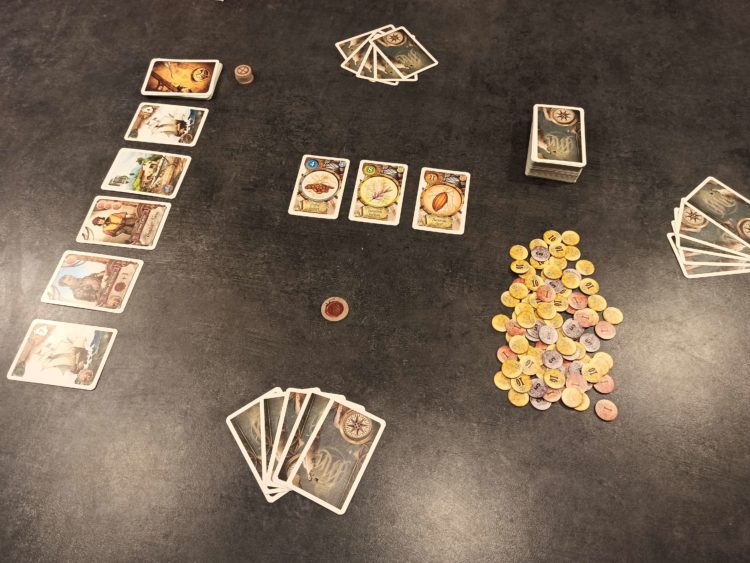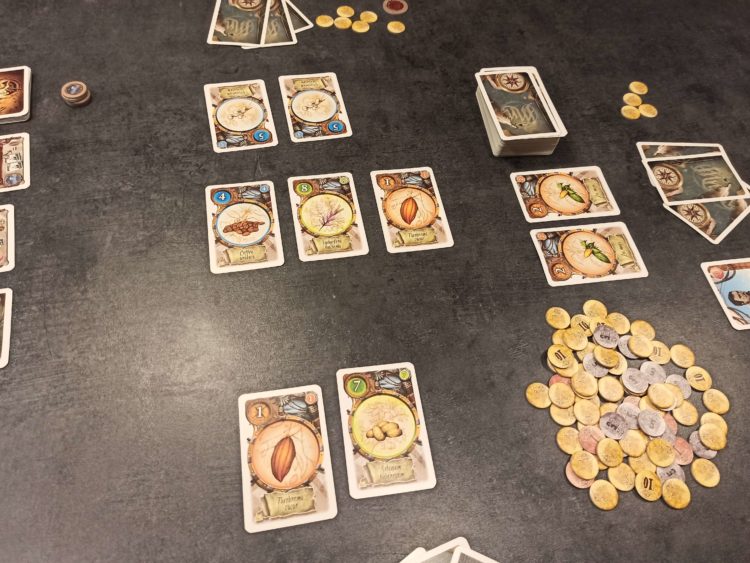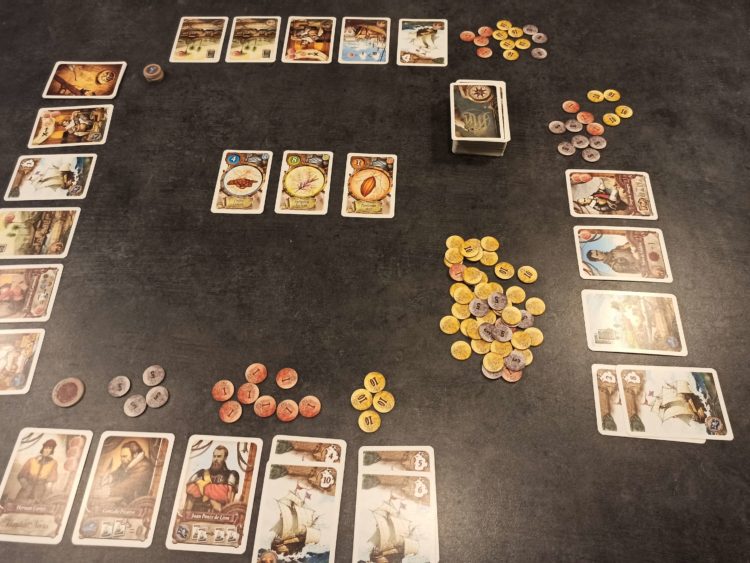
OBJECTIVE OF MUNDUS NOVUS: The objective of Mundus Novus is to become the richest by acquiring and selling goods.
NUMBER OF PLAYERS: 2 to 6
MATERIALS:
- 1 Trade Master token
- Doubloon tokens (30 tokens of value 10, 30 tokens of value 5 and 30 tokens of value 1)
- 120 Resource cards: 16 cocoa (1), 16 corn (2), 16 tobacco (3), 12 coffee (4), 12 cotton (5), 12 sugar cane (6), 8 potato (7), 8 indigo (8) 8 vanilla (9), 12 Inca relics
- 44 Development cards with specific effects
- 6 Event tokens
TYPE OF GAME: trading card game
AUDIENCE: teen, adult
OVERVIEW OF MUNDUS NOVUS
In each round, the players collect goods cards (cocoa, tobacco, indigo, potato etc…)… but must put some of them in the exchange. Once these exchanges are over, you can combine your cards in two different ways: by making series of at least 3 identical cards to take Developments (caravels, warehouses, characters…), or by combining different cards to earn doubloons.
SETUP
At the beginning of the game, carefully mix the Resource cards, and then the Development cards. After that, 3 Resource Cards are placed face up next to the Resource cards pile to make up the Market. In the same way, 5 Development Cards are revealed and placed in line, one after the other (the order is important). The Event tokens are placed next to the Development deck, and the Trade Master token goes to the youngest player. Doubloon tokens are placed next to the playing area.

GAMEPLAY
A game is played in an undetermined number of rounds, each consisting of four phases:
1. Event: If the first of the Development Cards (furthest from the Development Deck) has an event symbol (bottom left of the card), then the event is activated. There are 5 different events:
- King’s Help: allows players to acquire more than one event card per turn
- Natives: combinations of different Resource cards yield only one doubloon per card instead of the normal combination value
- Storm: prevents the acquisition of Development cards, except for the first card in the queue, regardless of the played combination
- Fire: renders the players’ warehouses unusable at the end of the turn
- Pirates: causes each player to lose one Resource card per squadron of two (or more) caravels in their possession.
2. Supply: Each player receives 5 Resource cards. In addition, draw and place on the table as many Resource cards as there are caravels in play. These cards are collected by the players in ascending order of the strength of their squadrons (the lower the value of a squadron, the faster it is, and the quicker it reaches the Mundus Novus).
3. Exchanges: The Trade Master chooses a number between 2 and 4, then each player simultaneously reveals as many Resource cards. The one who has revealed the largest sum becomes the new Trade Master. He begins this phase, during which each player chooses a card placed by an opponent, then exchanges it, if he wishes, for one from the market. In both cases, he takes the resulting card in his hand. This continues until all the cards are dealt.
4. Progression: the Trade Master chooses who starts. In turn, each player places one combination of cards from his hand. They must all be the same kind of resources or all have a different number.
If they are the same kind of resources, they allow you to take a Development card from the queue. The possible choice is more or less important depending on the number and value of the cards played, as shown below:
| Common resources | Rare resources | Very rare resources | |
| 3 cards | 1st card | Among the first 3 cards | Any card |
| 4 cards | Among the first 3 cards | Any card | / |
| 5 cards | Any card | / | / |
As soon as a Development card is bought, a new one is drawn and placed in fifth position.
If they are different, they are sold for doubloons, as shown below:
| Number of cards | 4 | 5 | 6 | 7 | 8 | 9 |
| Doubloons | 5 | 7 | 10 | 15 | 20 | 25 |
Inca relics can be used as a joker in any combination, or can be played as a combination of relics with the following gains:
| Number of relics | 1 | 2 | 3 | 4 | 5 |
| Doubloons | 3 | 7 | 12 | 18 | 25 |

Development cards
Some Developments bring doubloons at the beginning of each turn (as well as at the turn when they are obtained), as shown in the top right corner of their card.
- Caravel: grants one Additional Resource per turn (Supply phase)
- Shipyard: earns 1 doubloon per opponent with more caravels than the shipyard owner (end of turn)
- Merchant: Allows you to exchange any Resource for a Resource shown on the map (once per turn, Progression phase).
- Warehouse: allows you to store one or more Resource cards at the end of the round, as indicated on the card.
- Diego de Almagro: earns 2 doubloons per turn, and allows you to draw a Development from the deck instead of taking from the revealed Developments.
- Juan de la Cosa: earns 1 doubloon per turn, and makes immune to all events (even the King’s Help)
- Gonzalo Pizarro: reduces the value of the player’s strongest caravel to 0
- Bartolomé de la Casas: earns 1 doubloon per turn, and allows to place less cards for exchange than required by the Trade Master (including 0).
- Juan Ponce de Léon: allows to divide its caravels into two squadrons, treated separately during the Supply phase (and the Pirates event)
- Pedro de Valdivia: earns 1 doubloon per round and 3 points when determining the Trade Master.
- Francisco de Orellana: Allows you to win 2 doubloons in a trade if, after the trade, the 3 cards in the Market are identical or if their numbers follow each other.
- Francisco de Coronado: allows you to pay 2 doubloons to choose the event applied in a turn where there is no event.
- Hernan Cortes: earns 3 doubloons per turn
END OF GAME
The game ends in the following cases, to be dealt with in descending order of priority:
- a player places a combination of the 9 different Resources AND an Inca relic: he automatically wins the game (if several players make the perfect combination in the same turn, the richest of them is the winner)
- one or more players reach or exceed 75 doubloons: the richest player wins the game
- The event card pile is exhausted: the player with the most doubloons wins the game.

Enjoy! 😊
- Comprehensive Guide to the Board Game Go (weiqi, baduk) - January 23, 2024
- Are Creative Suites Changing Gaming - October 30, 2023
- How Classic Games Have Been Reimagined for Modern Audiences - October 5, 2023